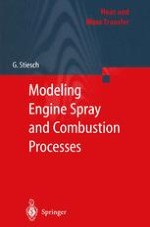2003 | OriginalPaper | Chapter
Phenomenological Models
Author : Dr.-Ing. Gunnar Stiesch
Published in: Modeling Engine Spray and Combustion Processes
Publisher: Springer Berlin Heidelberg
Included in: Professional Book Archive
Activate our intelligent search to find suitable subject content or patents.
Select sections of text to find matching patents with Artificial Intelligence. powered by
Select sections of text to find additional relevant content using AI-assisted search. powered by
While the thermodynamic combustion models described in Chap. 2 are relatively easy to handle and are characterized by a low computational effort, they are lacking the ability to make predictions of the effects of important engine parameters on combustion without prior measurements. The main reasons for this deficiency are that major subprocesses are either not modeled at all or described by solely empirical correlations and that the assumption of an ideally mixed combustion chamber makes it impossible to estimate pollutant formation rates that are strongly affected by local temperatures and mixture compositions. On the other hand, the multidimensional CFD models that are based on the locally resolved solutions of mass-, energy- and momentum-conservation and that include detailed submodels for spray and combustion phenomena, are computationally expensive, and they demand that the user has a much deeper understanding of the governing physical and chemical processes in order to correctly interpret the simulation results. Moreover, the predictive quality with respect to global quantities such as pressure traces and apparent heat release rates is not necessarily better than with simpler models. This is because the many subprocesses taking place inside a combustion chamber are often interacting with each other such that relatively small errors encountered within particular submodels may add up to a considerable error in the overall result of the computation.
